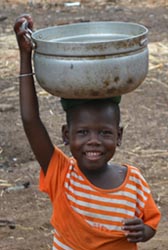 |
How are N2Africa activities linked with the dietary intake of infants and young children like this Ghanaian girl Talata? And how do the activities trickle down to the nutritional status of these infants and children and therefore their productivity later in life? The majority of the undernourished population in the world live in rural households in developing countries. Farming is their mainstay and often the only means to access of food and income. Evidence for theoretically assumed linkages between agriculture and nutrition is, however, weak. In the context of the N2Africa project, we will research the linkages between agricuture and nutrition and their drivers in rural households. |
My main objectives and their progress:
- To assess the role of legumes in the sub-Saharan African diet: their nutritional values, and their current and potential role in the diet of young children
My literature research shows that grain legumes are better sources of protein and contain a larger variety and concentrations of micronutrients compared with sub-Saharan African staples like maize (in Podcaster 15). Dietary intake data is collected in Northern Ghana and in Western Kenya which I will use to analyze the current and potential role in the diet of young children with a linear modelling programme. - To assess the association between legume production and legume consumption, dietary diversity and nutritional status of children and its drivers
I conducted two case studies, one in Ghana and one in Kenya. In Ghana, a correlation was found between N2Africa and a higher nutrient adequacy of the diet of young children. Focus group discussions show female N2Africa farmers contribute directly to increase in food availability at home while male farmers sell most of their produce. It is unclear how and if improved sales may trickle down to improved diets (links to Podcaster 22, 29 and N2Africa TV). - To assess the association between crop diversity with dietary diversity and nutrient gap
The research is a preliminary phase. Analyses will be done both at detailed level in Northern Ghana, and at broader scale with existing data sets. - To re-design and test farm systems based on nutrient gap analysis at food level
Detailed nutrition data is collected in Northern Ghana and analyses are in progress, for preliminary results see previous Podcaster (31).
More in depth insight in the linkages between agriculture and nutrition will offer guidance to shape N2Africa activities or activities of other agriculture projects in such a way that increases in yield or increases in diversity of foods produce trickle down to improved dietary intake of Talata.
Ilse de Jager, Wageningen University, The Netherlands
* Talata is a real person but a fictitious name
